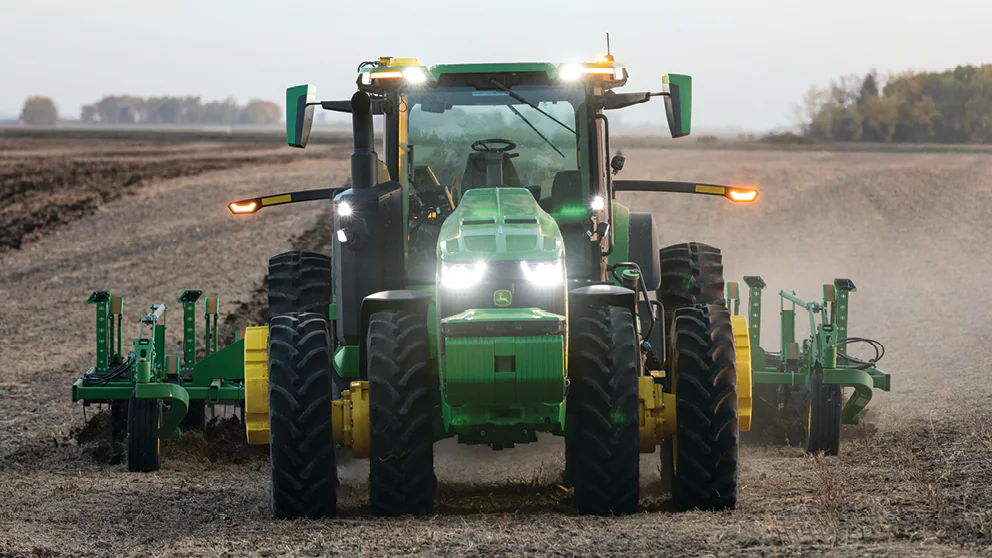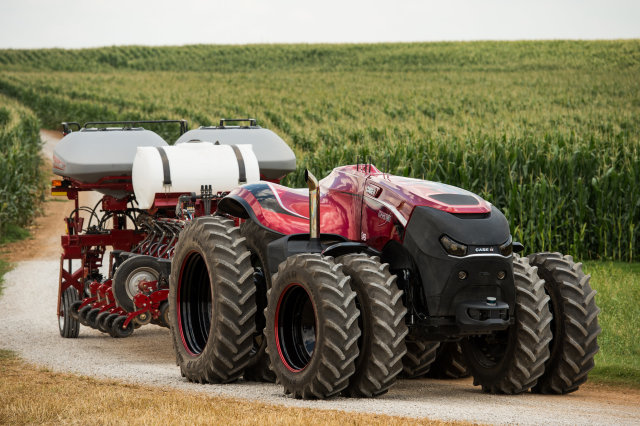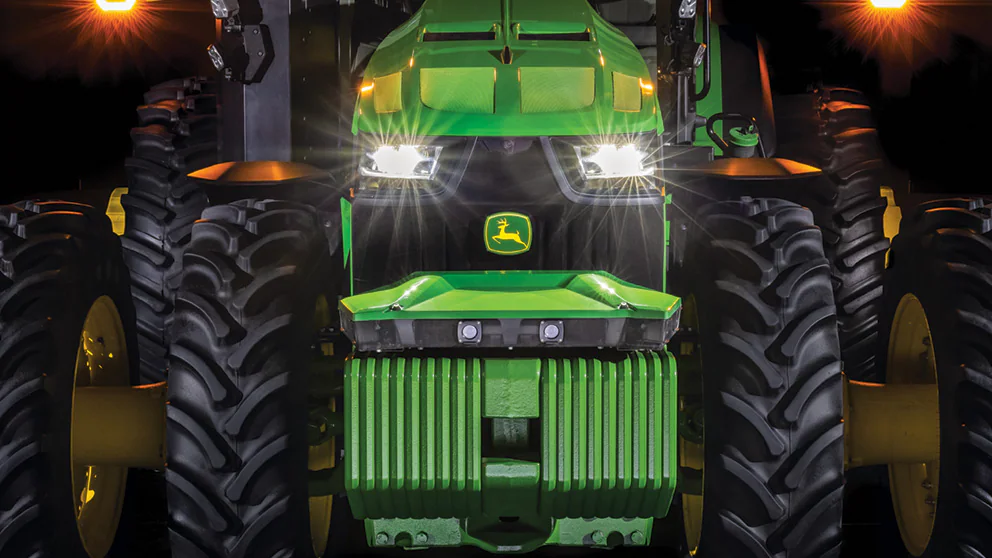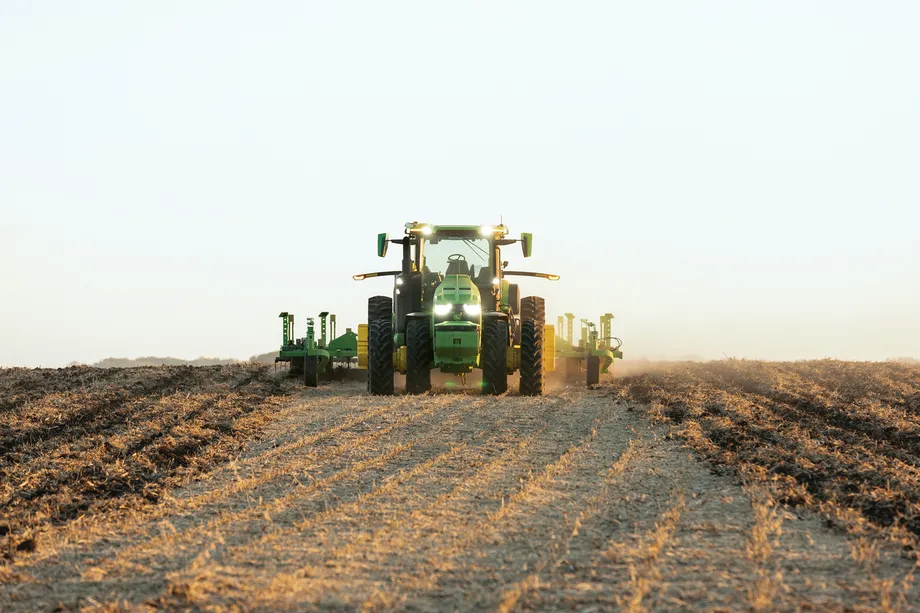If you have been following news in technology and the auto industry, you probably already know that almost every mainstream car company is in the race to make the first autonomous/self-driving car. Besides the mainstream automotive companies, farm tractor makers have also made several advancements in creating autonomous tractors.
With the ever-rising demand for food, there is a need for inventions like autonomous tractors in order to boost the global food production capacity. It should be noted that tractors have been around for over a century, but the revolution to make them fully autonomous is an initiative that began a few years back.
In today’s article, we will discuss everything you may need to know about autonomous tractors and why they will be very crucial to the future of farming. Without wasting any more of your time, let’s jump right in.

John Deere, a global leading tractor manufacturer, announced their new autonomous tractor.
What Exactly Is An Autonomous Tractor?

It’s a farm tractor designed to do specific farming operations without needing a driver. An autonomous tractor has the ability to move around the farm doing tasks like plowing or planting seeds without the need for human intervention. Automating certain aspects of tractors has been going on for a couple of decades now.
However, we haven’t had a fully autonomous tractor that doesn’t need a driver until we saw John Deere release their first version at the 2022 CES. John Deere had been working on this tractor for the past couple of years before this announcement. This tractor was not just a concept vehicle to showcase an idea, but a tractor that will be ready for shipping by the end of 2022.
This tractor looks futuristic, and I am guessing this was done intentionally to differentiate it from the traditional farm tractors we are all used to. Deere’s tractor can be controlled via a smartphone through their custom-built application. Unlike mainstream self-driving cars, there is no need for anyone to move within the tractor as it does the work. You simply have to monitor it via the app to see how far it has gone and the progress made on the task at hand.
Video credit, visit: CNET for more
How Does An Autonomous Tractor Work

At this point, you might be asking yourself how autonomous tractors are able to move around obstacles on the farm while doing their job. Let me explain.
Besides the primary driving mechanism that all tractors have, an autonomous tractor comes with a computer integrated into all its systems. All the decisions made, including the driving speed, maneuvering around obstacles, and more, are done by the computer. The computer gets data from other hardware devices that may include a set of cameras, lidar scanners, GPS sensors, proximity sensors, and more.
On the software side, the computer uses technologies, including machine learning and computer vision, to interpret the data sent from the cameras. The decisions made are usually in real-time, thanks to the powerful computing capabilities of the CPU and GPU used in the computers integrated into autonomous tractors.
Of course, there is a need for a person to closely monitor and control the tractor via a mobile app if they decide not to be onboard. Their role is to determine the task the tractor should do and how it should do it. They can also choose when to stop the tractor if it is done with the designated job.
Benefits of Autonomous Tractors

1. Eliminates human errors
Since these tractors are driverless, all the decisions they make are based on the pre-determined commands in the software running on its computer. If the software is bug-free, the tractor will always do the job as desired without any errors. Remember, humans are emotional, so sometimes tractor drivers can make emotional decisions that may cause damage.
With autonomous tractors, all the side effects of the emotional decisions that might be made by drivers are eliminated since the tractor uses data gathered by its hardware devices to make decisions. The good news is that autonomous tractors continue to learn the more distance they cover since they collect data along the way.
This means that an autonomous tractor with more mileage will likely make better decisions than a brand new one.
2. Software updates can improve its capabilities and performance.
When you buy any other ordinary tractor, it will only do the tasks it was designed to do when you purchased it. With an autonomous tractor, things are a bit different. Manufacturers can always roll out software updates to improve or add more capabilities to the tractor, with the only limitation being the tractor’s hardware.
If the tractor has the necessary hardware required to do a specific task, the manufacturer can roll out a software update to enable that functionality. While designing autonomous tractors, manufacturers consider several possibilities and functions that can be tweaked with software in the future.
That is why some of these tractors will come with under-utilized hardware at the time of purchase. The manufacturer can then keep rolling out updates until all the hardware capabilities of the tractor are fully exploited. Some updates are meant to fix any bugs and errors in the initial software the tractor came with. So, like your smartphone or computer, an autonomous tractor will also improve over time.
3. They gather and analyze more data.
Autonomous tractors are also built with sensors that gather data about the soil and other field conditions. This may include the soil’s moisture content, acidity, nutrients, crop health and more. The built-in computers on these tractors can then analyze this data to give the farmer information they can use to make certain farming decisions.
The data collected by these tractors can also be used to determine if the farmland’s ability to grow certain crops is changing over time. There are many other insights that the farmer can get from data gathered by these tractors. So, if you buy an autonomous tractor, you will have got yourself a tractor to do several farming operations by itself and a machine to gather data that you can use to make crucial decisions and strategize how to improve your farm.
4. They help deal with labor deficits in the farming sector
Developed countries like the US and Canada are experiencing labor shortages in the farming sector, at least in some regions. With autonomous tractors, this labor shortage can be dealt with since they don’t need full-time drivers to operate them. One person can be used to monitor several autonomous tractors on the farmland.
Using autonomous tractors also lowers labor costs in the long run. Yes, the prices of these tractors are way too high, especially now that the technology is still in its early stages. However, these costs can be recovered if the tractor is used to take on tasks initially done by several humans. Ultimately, it will be cheaper to use an autonomous tractor in the long term than to use humans or manually controlled tractors.
5. Boost farm productivity
One of the fundamental goals for creating autonomous tractors is to boost the overall productivity of the agricultural sector. Since they are not manually operated by humans, these tractors can be deployed for longer hours, leading to more work done per day. They can also be used at night since they have strong lights that will enable cameras to continue functioning even in the dark.
These tractors can also continue working during bad weather conditions where humans would struggle or be less productive. It should also be noted that autonomous tractors can do certain tasks faster than manually controlled tractors. This leads to more work done in less time. Overall, you will get more output when you deploy autonomous tractors over manually controlled ones.
6. More accuracy
Another benefit of using autonomous tractors is the improved accuracy in doing certain farm operations, including seeding, weeding, harvesting, and more. This accuracy can even be improved over time if the manufacturer rolls out updates geared towards enhancing the precision in doing certain tasks.
7. Increased safety
As a bonus, using autonomous tractors can boost the safety of other operators and animals on the farm. A self-driving vehicle can make certain real-time decisions that human drivers may not make due to emotions. This can potentially save the life of a farm operator or an animal moving around on the farm.
So, besides the increases in efficiency and productivity, these tractors will also boost your farm’s safety. These tractors are designed with safety in mind. They will always choose to stop moving immediately if they sense any chances of causing a fatal accident to a human being or animal. The tractor will also stop if it detects the possibility of damaging itself.
Limitations of Autonomous Tractors

Autonomous tractors are indeed the future of tractors. However, there are some limitations that need to be addressed by the relevant stakeholders if the majority of the farmers across the world are to benefit from this invention. The following are some of the limitations that need to be addressed.
1. Pricing
The starting price of John Deere’s autonomous tractor is over $600,000, which is way too high for medium and small-scale farmers. Even the large farms will find it pretty hard to justify a $600,000 expense on a tractor. However, such prices are very common with new technologies mainly due to the high R&D costs incurred during the early stages of development.
These autonomous tractors consist of several custom parts, including custom silicon to enable the computing tasks that are specifically designed for tractors. Creating these custom parts requires a lot of R&D investment. These costs are later transferred to the final consumer, which is why autonomous tractors will be very expensive in the early years.
Of course, we expect prices to decrease over time as manufacturers learn more efficient and cheaper ways to make these tractors. Prices will also go down as more players get into the competition. At the moment, we only have a handful of companies that are promising to ship autonomous tractors in the near future. We expect to see more companies get onboard soon.
2. Loss of jobs
This will be an issue in regions still having high unemployment levels. Most of the developing countries have a considerable section of their workforce working in the agricultural sector. When the large farms in these countries decide to shift to autonomous tractors, millions of people in the agricultural industry will lose jobs.
The victims will most likely be the casual laborers and drivers of manual tractors. These large farms will probably prefer workers with more sophisticated skills to take full advantage of the capabilities of autonomous tractors.
3. Fear of Machine error
If anything goes wrong with an autonomous tractor, it will cause more damage than a manually controlled tractor. Of course, these tractors are designed to be as safe as possible. However, you cannot guarantee that it will never encounter errors in its lifetime. That is why it is important to have someone to constantly monitor the tractor as it does its operations.
4. Security concerns
Since autonomous tractors have computers constantly connected to the internet, they are prone to computer problems, including cyber-attacks. A hacker can potentially cause havoc on the farm if they gain control over the tractor. As we shared earlier, these tractors are designed to be highly safe. However, you can’t rule out the possibility of cyber-attacks, especially if the tractor owner isn’t careful about who gets access to the tractor.
Bottom Line

It will take several years, if not decades, for autonomous tractors to become mainstream. These tractors have many benefits that can boost the productivity and overall efficiency of farm operations. However, the major caveat to adopting these tractors is their pricing. Prices of autonomous tractors must drop significantly if these tractors are to become mainstream in the future.



